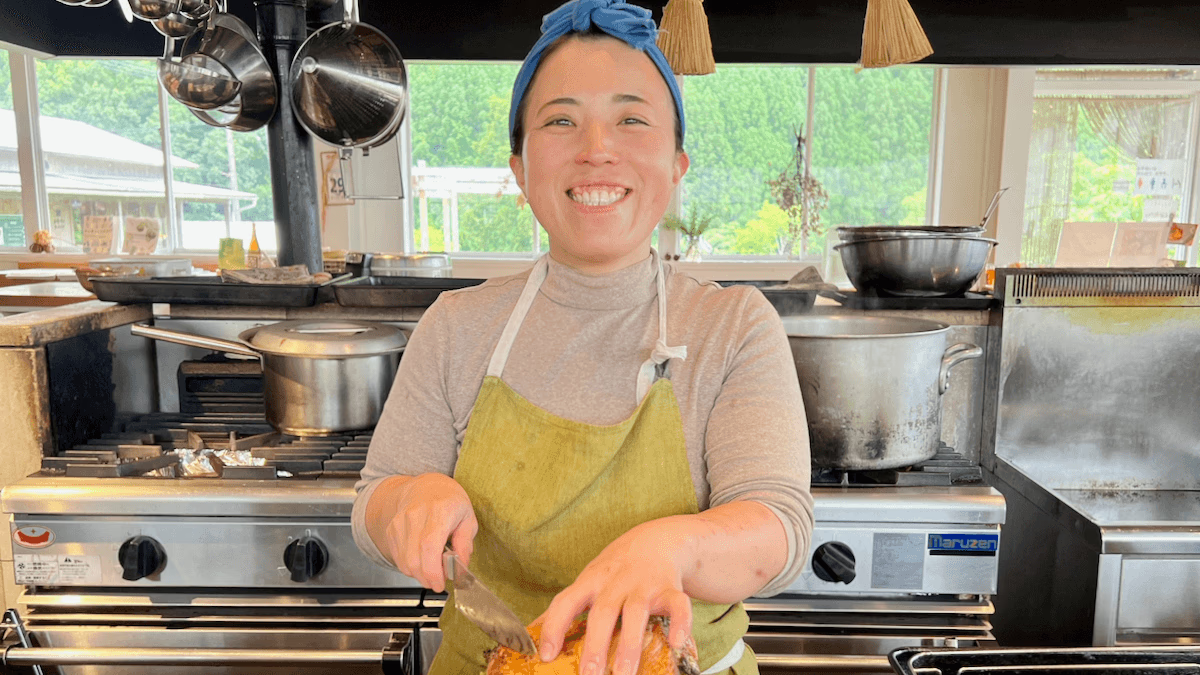モノサスが創立に関わった、徳島・神山町のフードハブ・プロジェクトは、今年で8年目を迎えました。同じく8年前から神山に通うわたしにとって、食堂「かま屋」とパンと食料品のお店「かまパン&ストア」は、いつ行っても誰かに会えておいしいものを食べられる、しあわせな場所になっています。
現在のかま屋の料理長は、もぐさんこと清水愛さん。初めてもぐさんの料理を食べたときのこと、今でも覚えています。メインは、阿波美豚のクレピネット焼き。「お肉はちょっと重たいかな」と心配していたのにするっとお腹に納まって。シンプルかつ奥深い野菜スープの味わいと、一皿ごとの仕上がりのバレリーナの指先のような繊細さ。しかも「どや!おいしいやろ!」と迫ってくる圧はなく、大事にされているあたたかみがあるというか......。
おっと、語りにちょっと熱が入りすぎました(ただのファン)。
今回の「めぐるモノサシ」は、もぐさんにインタビュー。どんな道筋をたどってフードハブにやってきたのか、料理をしていて一番うれしいのはどんなときなのか、じっくり聞かせていただきました(トップ写真は、かま屋スタッフ大野美砂さんが撮影してくれました!)。
徳島市出身。調理師専門学校でフランス料理を学んだ後、淡路島のホテルに就職。レストランキノシタ、ムッシュ・ヨースケ、レストラン・オギノで働いたのち、2019年10月にフードハブ・プロジェクトに入社し、食堂かま屋の料理長に。シェ・パニース元料理長のジェローム・ワーグ氏から厚い信頼を得ながら、かま屋のメニューをつくっている。
「あのシェフに叱られて鍛えられたい」と21歳で代々木のレストランへ
ー もぐさんは、どうしてお料理を仕事にしようと思ったんですか?
清水 小学生のとき、父の友人たちにクリームシチューをつくって出したら「すごくおいしい!」って言ってくれたのがすごくうれしくって。食べるのもすごく好きで。高校生になるとバイトしては食べ歩きに行っていました。高校卒業後は地元・徳島の調理師学校で一年間和食、洋食(フランス、イタリア料理、中華を学び、淡路島にあるホテルで2年半働きました。当時はSNSなどの情報源がなかったので、東京に食べ歩きに行って自分が行きたいお店を探して、代々木の「レストランキノシタ」に転職しました。
ー どうして、レストランキノシタで働きたいと思ったんですか。
清水 食べたときにもう、自分がおいしいって思う味だと思ったんです。この味を習得したいと思いました。レストランキノシタは半オープンキッチンで、シェフとスーシェフ(sous-chef、副料理長)の姿が見えるんです。そのとき、スーシェフが後輩に対してすっごい激怒しているのを見て、「あのスーシェフのもとで叱られたい」と思って。
ー 「怖い!」って思うんじゃなくて、この人に鍛えられたいと思った。
清水 はい。こんなふうに熱意ある人に教わりたいと思いました。淡路島のホテルは小さなリゾートホテルだったので、いろんなポジションをひととおり経験して少しはできる気になっていたけど、レストランキノシタに入って「こんなにレベルに差があるのか」と毎日が挫折の日々でした。予約の取れない人気店だからすごく忙しくて。ミスが重なるうちに心が折れて半年で辞めてしまいました。でも、自分が納得できないお店には行きたくなかったから、レストラン近くのスーパーのレジで働いていたら、買い出しに来たシェフやスーシェフが「戻る気があるなら来ていいよ」と言ってくださって、3ヶ月後にまた同じお店に戻りました。
レストランキノシタで働きたい料理人は多くて、ホールスタッフは全員厨房待ちなんです。なのに、当時21歳だったから、若いし使いやすいと思われたのかもしれないけど、私は初日の午後から「厨房に入れ」って言われました。厨房待ちの人たちにしたら「お前、なんで先に入ってるんだよ?」ってなるのは当たり前で。戻ってからも、ちょっとミスするだけで先輩からキツく言われて精神的にも参ってしまって、半年後にまた辞めることになりました。
「これぞ」と思うものを突き詰める料理人になりたい
ー もぐさんが参ってしまうとは、相当にキツかったんでしょうね。その後はどうしたんですか?
清水 レストランキノシタで働いていたときに、マダムに連れていってもらった中目黒の「ムッシュ・ヨースケ」というお店で6年半働かせてもらいました。このお店では、シェフの名刺がわりの料理として一皿目に「ズワイ蟹とエノキ茸のキッシュ」が出てくるんです。お料理の一つひとつがすごくていねいで。それまでは「いろんなことをすべてできるにはどうしたらいいんだろう」と思っていたのですが、ヨースケさんのお料理を食べて「自分が『これぞ』っていうものを突き詰めた料理人になりたいな」と思いました。
ところが、ムッシュ・ヨースケで働いて5年目、レストランキノシタのスーシェフだった荻野伸也さんに「独立するから来ないか」と誘われたんです。すぐには行けなかったけど、ムッシュ・ヨースケでしっかり仕事をまっとうしてから、荻野さんが2007年にオープンした「レストラン・オギノ」に行かせてもらいました。当時はレストランとソーセージやパテ・ド・カンパーニュなどの食肉加工をするシャルキュトリーもあり、私はそこでソーセージやパテをつくることになりました。
ちょうどその頃、荻野さんはつながりのある北海道の生産者さんたちから、「規格外で市場に出せない野菜や廃棄される魚があるんだけど」と相談されていて。道内の道の駅で、未活用食材をお料理に変えていく取り組みをはじめていたんですね。さらに、北海道の生産者さんから未活用食材を集めてお惣菜屋さんをつくろうという話が出てきたとき、私は「ぜひ行かせてほしい」と志願しました。
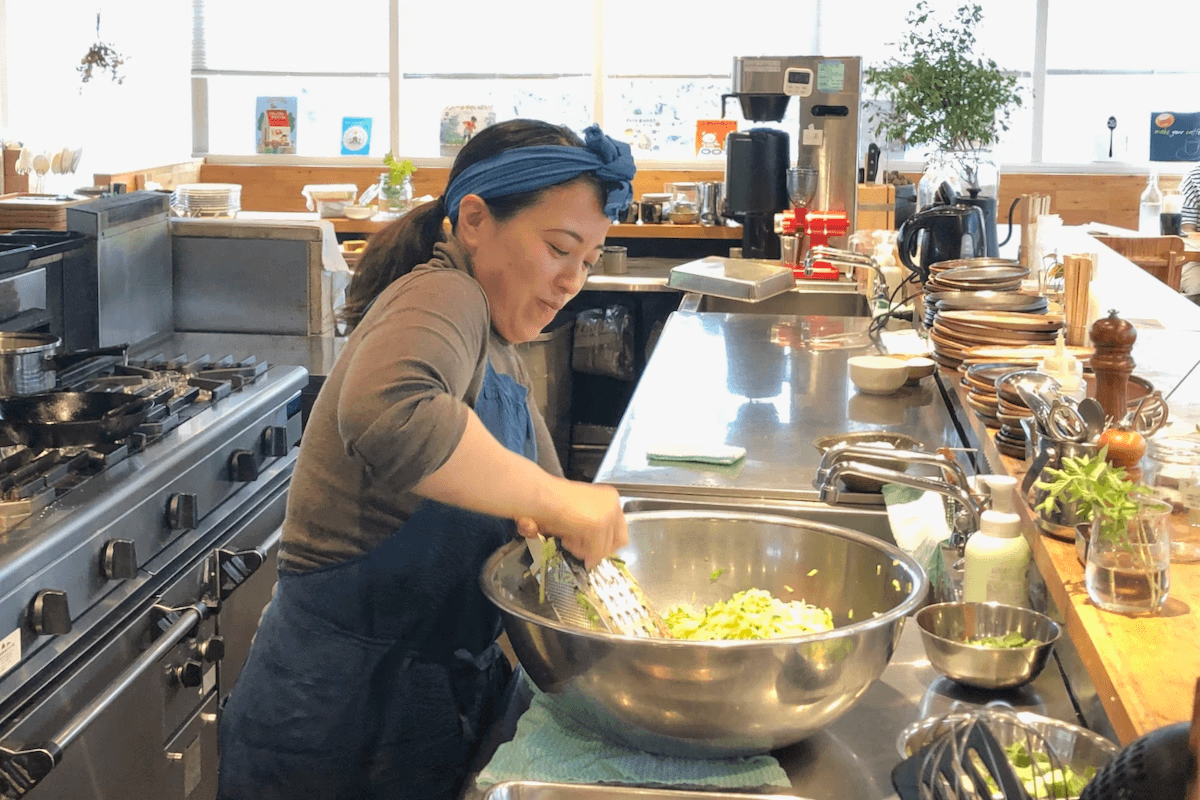
かま屋の厨房で料理するもぐさん。おいしいものが生まれている感じがします!
生産者さんから届いた食材でメニューをつくる
ー なぜ、北海道に行きたいと思ったんですか?
清水 当時は「将来は地元に戻って自分のお店を開きたい」という最終目標に向かって、東京でもがきながらもやっていました。でも、東京でやっていることをそのまま田舎にもってきてもなかなか商売は難しいので、地方の食材がある場所で働いてみたくて。未活用食材を使うというフードロスへの取り組みも、生産者さんを訪ねて食材に触れながら料理ができる環境もいいなと思ったんです。2010年に北海道に行って、丸井今井札幌本店でオープンしたお惣菜の店「ヴィヴル・アンサンブル プロデュイオギノ」で5年間働きました。そこでは、今かま屋でしているのと同じように、料理に合わせて野菜を注文するのではなく、「とうもろこしのB品があるから使ってくれないか」「ピーマンがたくさんあって困っている」という農家さんから相談をもらって、届く野菜からメニューを考えつつフレンチのお惣菜をつくっていました。
ー レストランで料理するのとお惣菜をつくるのは、料理人としてまた違う経験になったのでは。
清水 お惣菜屋さんは、飲食店よりもたくさんの人に食べてもらえる良さはあるのですが、セントラルキッチンと店舗が分かれていて、お客さんが食べている姿を見ることはできない。「おいしかったよ」という声や、売上の数字ではフィードバックを感じられるけれど、「果たしてこれは自分がやりたいことなのか?」という葛藤が出てきたんですね。悩んだ末に、「今まで自分ができることをやったけど、お客さんに温かいものを一番おいしい状態で食べてもらうことをやりたい」と思うようになりました。東京に戻る提案をもらったのですが、首都圏で「ターブル・オギノ」を展開していたお惣菜部門さんに所属することになってしまって。5年が経つともう自分は35歳で、今後どうするかをすごく悩んでいたときに、たまたま雑誌『自遊人』(2018年5月号)で「本当の地方創生、七つの物語」で特集されたフードハブ・プロジェクト(以下、フードハブ)の記事を読みました。気になって、かま屋に食べに来て、自分の目で見てから、Webフォームで「研修に行かせてほしい」と応募しました。
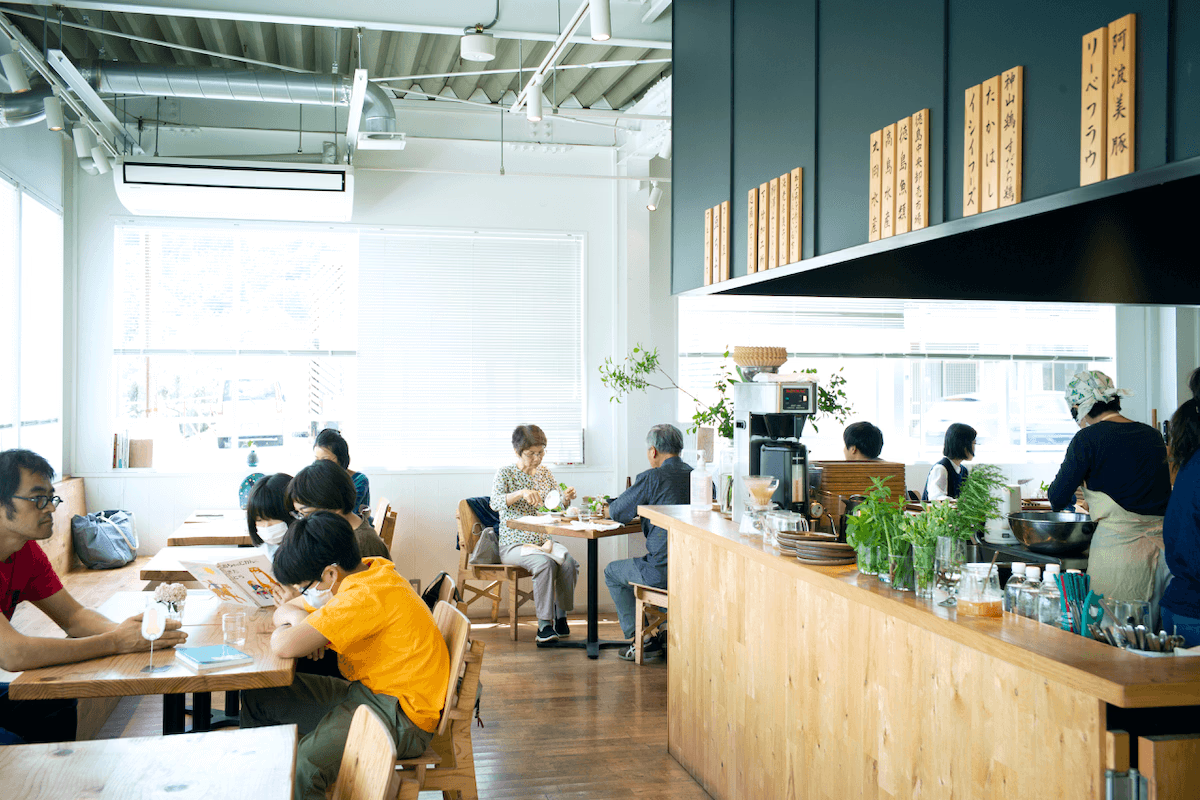
ある日のかま屋にて
フードハブで働きたいと思った理由
ー 初めてかま屋に来たときのこと、覚えていますか?
清水 おいしかったしすごくいい場所だと思いました。私がここで働いて、もっと良くしたいという思いもありました。かま屋には、店名の由来にもなったかまどがあります。私はお米が大好きなので、「このかまどでめっちゃおいしくお米を炊きたい」と思いました。実際に、料理長になってから、メンバーとも相談しながらお米の炊き方は工夫していきましたね。
ー それまで東京の人気店で働いてきたもぐさんが、フードハブで働きたいと思ったのはどうしてだったのか聞いてみたいです。
清水 フードハブには、パンや加工、食育、農業といろんなチームがあり、すぐそばに生産者さんたちがいる。こんなすばらしい環境で働けるところは、日本中を探しても他にないなと思いました。かま屋で働けば、自分次第でいろんなチームから学べるし、メンバーはすごく魅力的な人ばかりなので刺激しあえるのもいいなと思ったし。ひとつの飲食店のなかだけにいるとどうしても世界が狭くなってしまうけれど、フードハブはいるだけでいろんなインプットができます。また、かま屋もメニューから食材を発注するのではなく、今ある季節の野菜からメニューをつくるので、私が今までやってきたことも生かせると思ったのもありますかね。
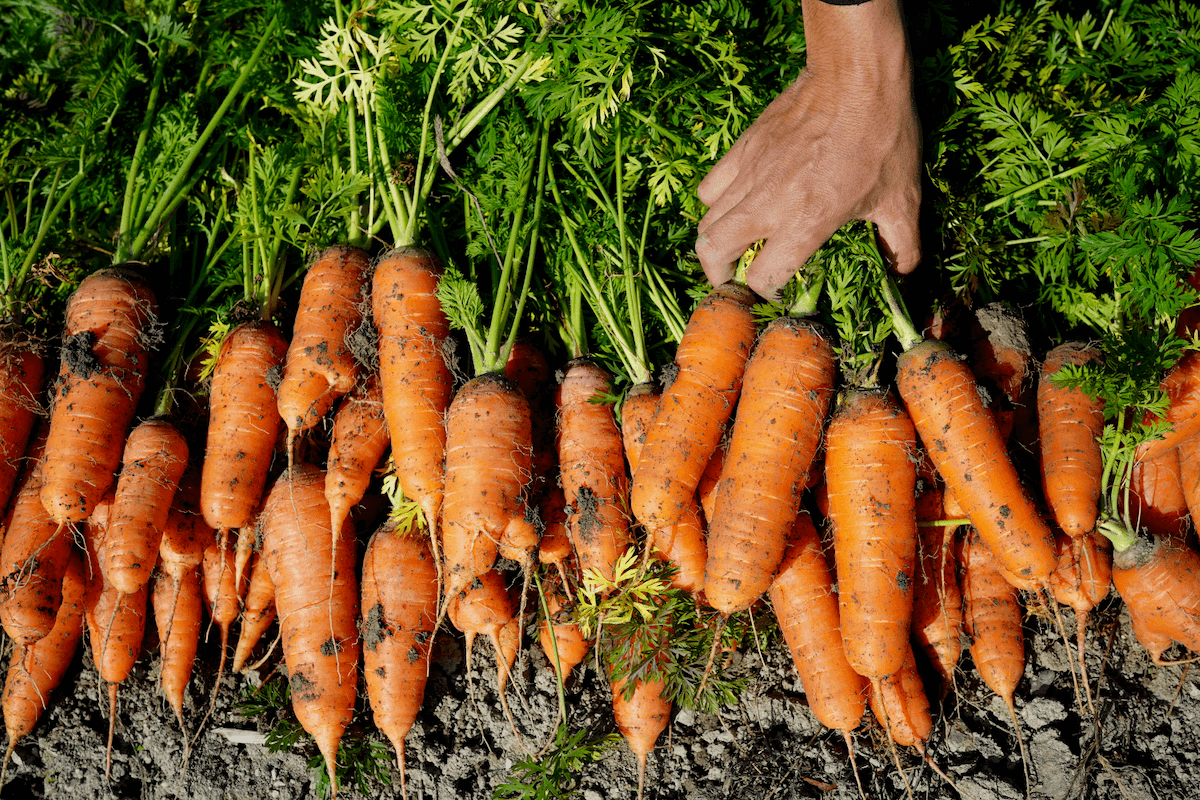
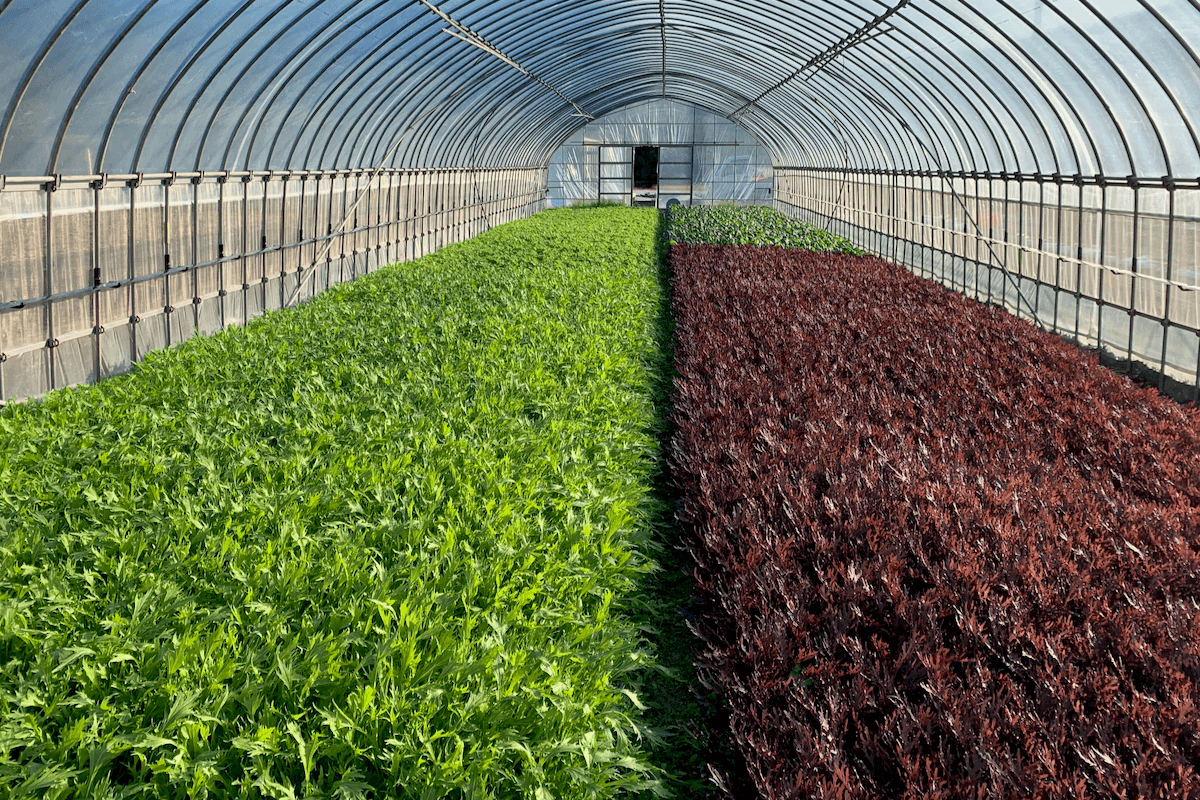
ー フードハブに入社したのはいつですか?
清水 2019年10月です。12月いっぱいまで前の料理長から引き継ぎさせてもらって、2020年1月から料理長になりました。当時のかま屋ランチは「おばんざいスタイル」でなかなか利益が出なくて。数字を見ながら発注ロスを改善していってもなかなか原価率が落ちない。そもそもおばんざいスタイルだと、客数が読めないので多めに仕込まないといけないうえ、日替わりメニューゆえの食材と手間のロスもありました。どうしたものかと思っていたとき、コロナ禍がはじまって。休業期間の間に、かま屋のメニューを考え直すことになったんです。
ー 眞鍋(太一)さんが、シェ・パニースの料理長だったジェローム(ワーグ)さんに相談したんですね。
清水 はい。ジェロームは、かま屋のランチを食べて「これだけいい食材といい環境があるんだから、もっと食材をシンプルに生かしたほうがいい」と思っていたみたいで。相談しながら、今の「定食スタイル」のランチができあがって、2020年5月27日にリニューアルオープンしました。
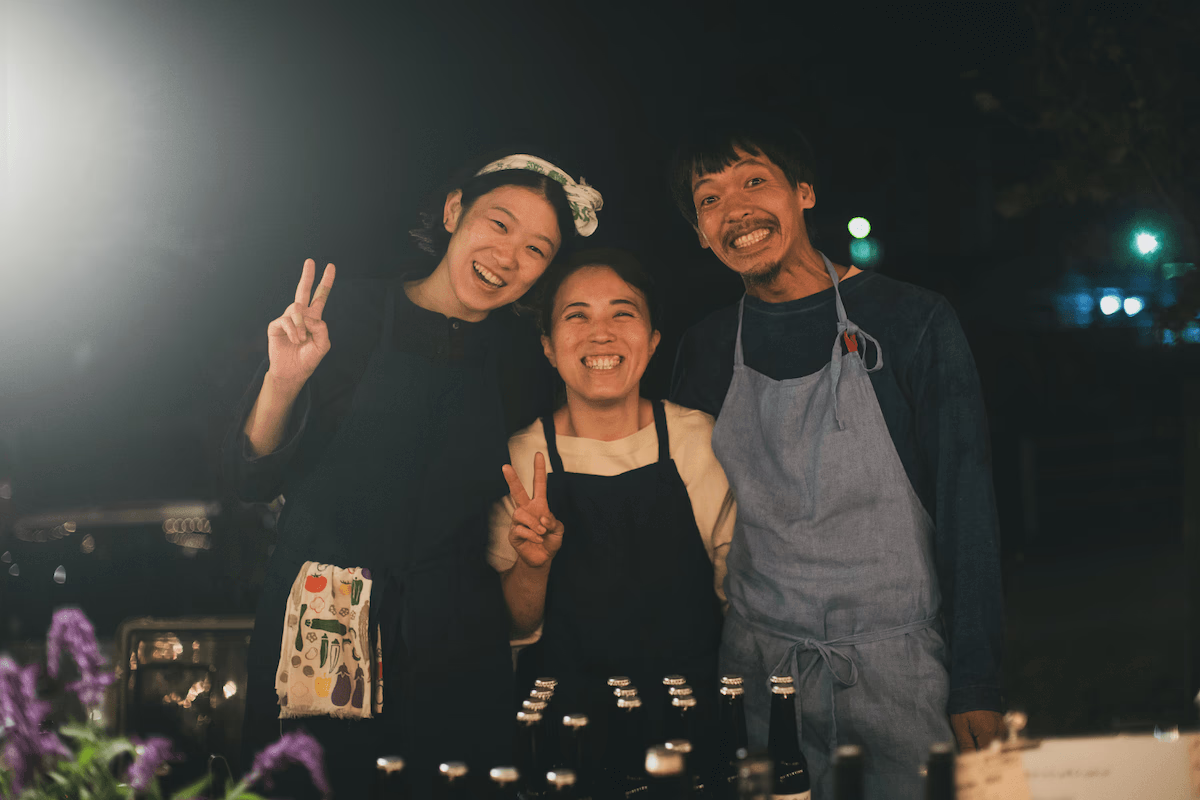
もぐさんがかま屋の料理長になったときのかま屋チームメンバー(撮影:生津勝隆)
「お皿のしごとは、農家が半分、料理人が半分」
ー ジェロームさんと一緒に仕事をしてみてどうでしたか。
清水 ジェロームの料理を食べて一番驚いたのはスープでした。フランス料理では、スープは鶏のダシをとり、野菜のダシをとり、野菜を炒めて一緒に煮込んでと、味を重ねて手間をかけます。でも、ジェロームは玉ねぎを炒めて、野菜と水を入れていい状態のときに回して塩で味付けするだけ。「たったそれだけで、なんでこんなにおいしいんだ!」って衝撃を受けたし、「私が今までやってきたスープの作り方って何なんだろう?」と考えさせられました。
ー 今までとはまた違う料理の世界がひらいたんですね。
清水 もちろん、フレンチのベースがあるからこそ応用ができる部分は絶対あるんですけど。「農家さんがつくる野菜を、一番おいしい状態にもっていくにはどうしたらいいか?」を考えるようになりました。以前は、「この料理、この味付けにもっていきたい」という発想だったけど、今は「農家さんが手塩にかけた野菜をどう生かして、味わってもらえるか?」と考えるようになりました。それが楽しいし、すごく刺激的で。本当にここに来てよかったです。
ー そこまで、農家さんの野菜を大事にしたいと思ったのはどうしてだったのでしょう。
清水 ジェロームがつくる料理を食べた衝撃に加えて、農家さんたちのしてくれていることをより深く知ったからです。たとえば、今の時期はカメムシが出るので、日中の暑さを避けてわざわざ夜中にカメムシを取りに行ってくれている。私たちがあたりまえに受け取っている「無農薬」「減農薬」の野菜は、農家さんのはかり知れない大変な努力によってつくられていると知って。ジェロームの「お皿のしごとは、農家が半分、料理人が半分」という言葉がほんとにスッと落ちました。今までは、お皿は自分たちがつくりあげると思っていたけど、いや全然違うなと思って。その頭を叩き割られた感じでした。反省しました。
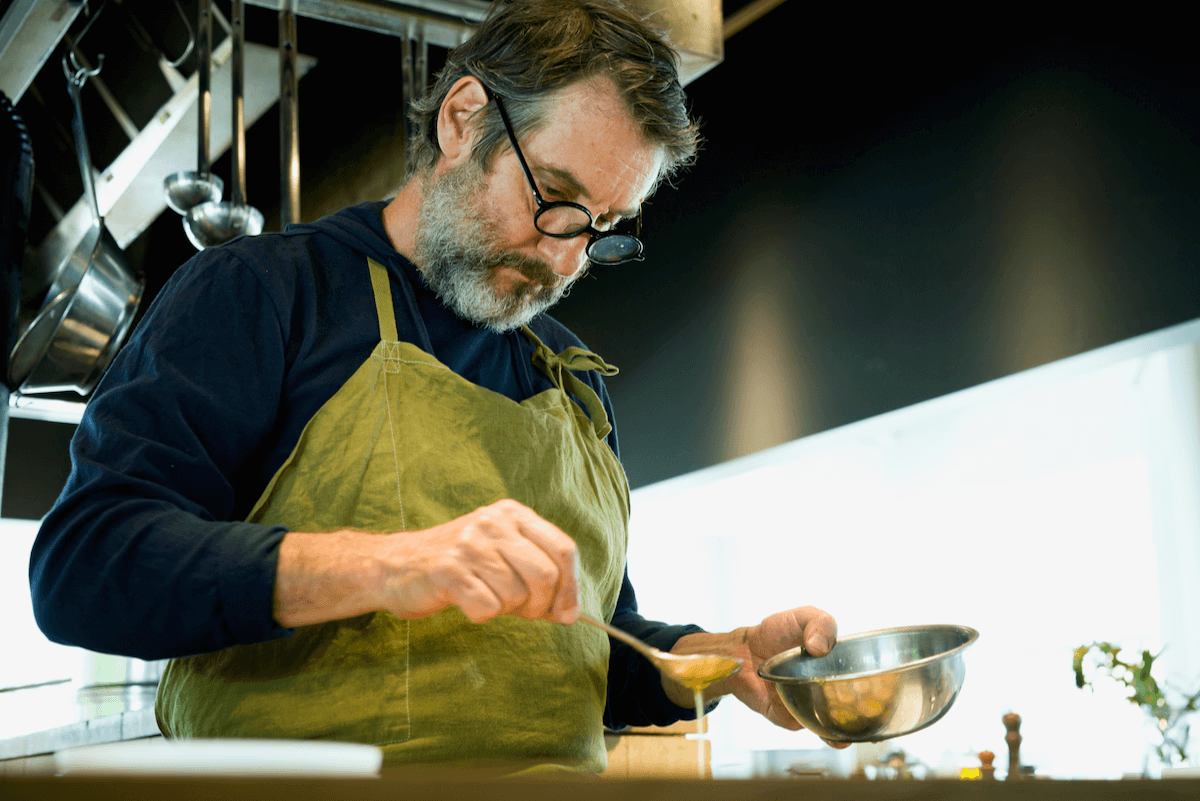
「お皿のしごとは、農家が半分、料理人が半分」。シェ・パニースの元料理長、ジェローム・ワーグさん。
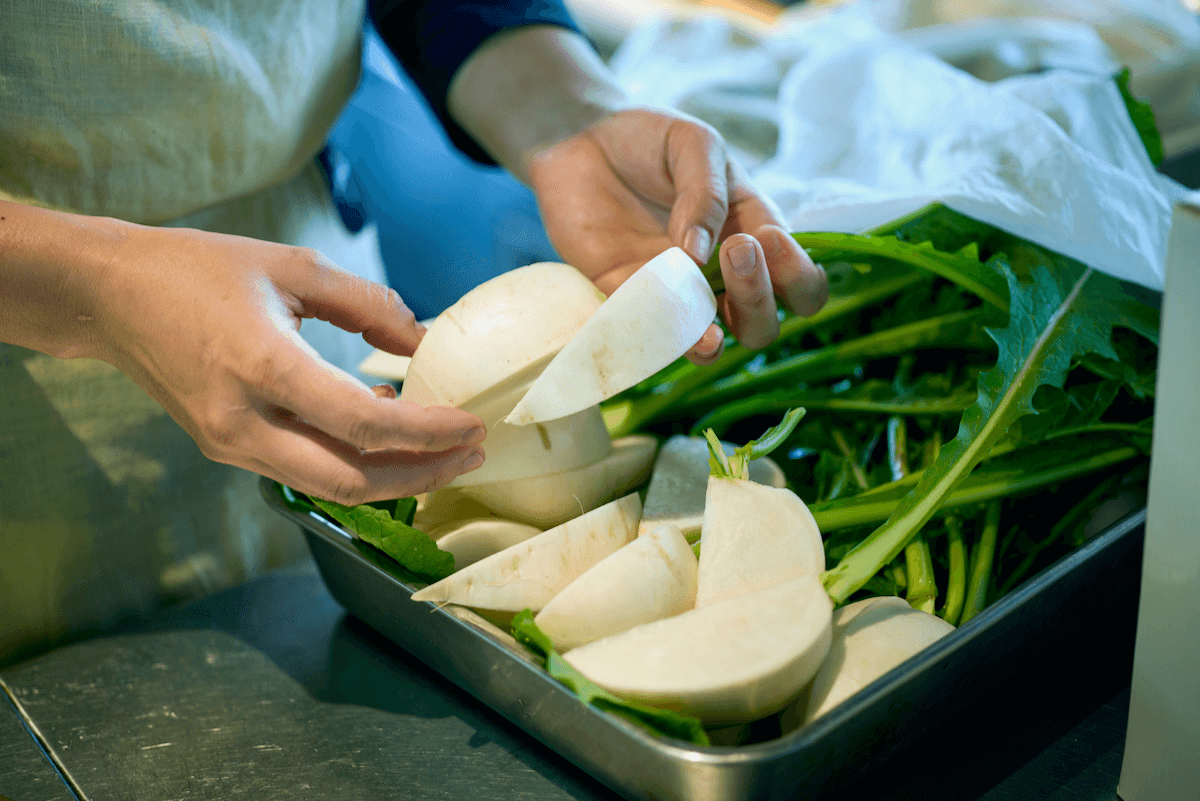
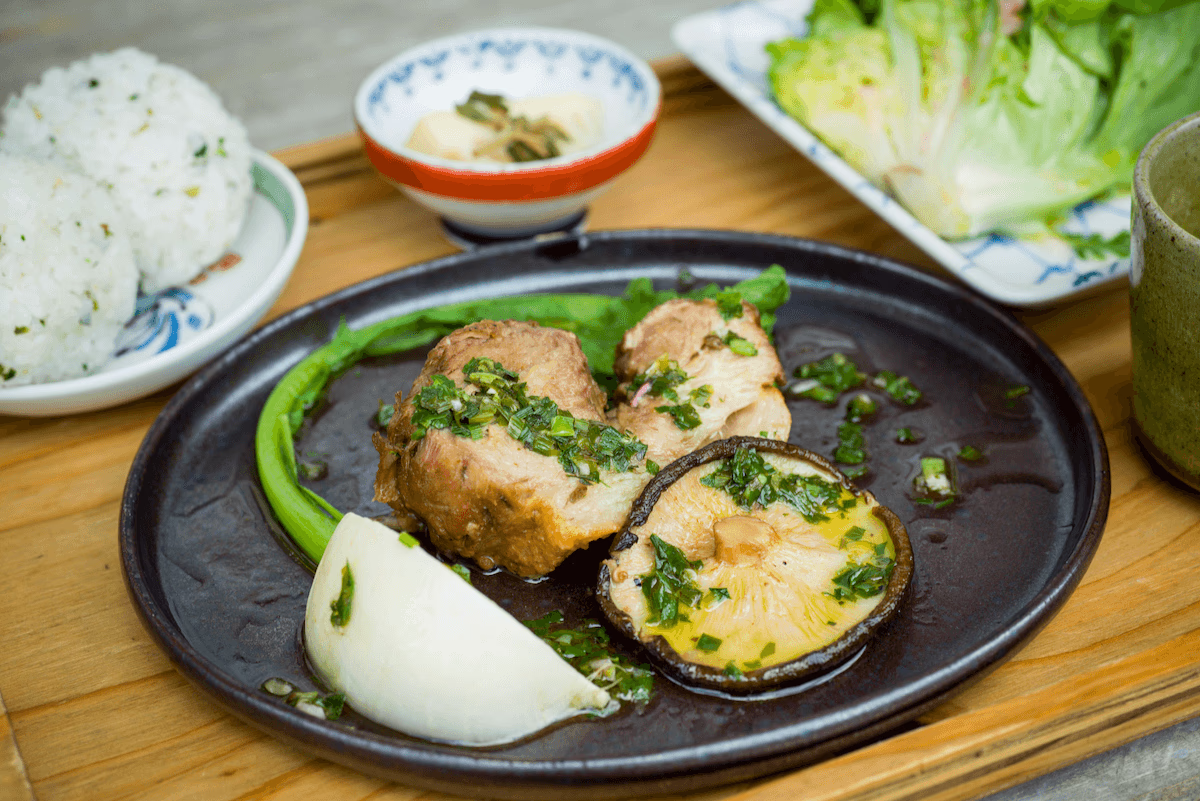
ー もぐさんは今、料理のお仕事をするなかで何を一番大事にしていますか。
清水 私自身がそうなんですけど、おいしいものを食べると活力になります。それをお客さんにできていたら一番うれしい。かま屋で出したものを食べた人がすごくしあわせになったり、「これを食べたらまた明日もがんばれる」という思いになってもらいたい。自分が理想とするものをチームとして届けられるように、メンバーとていねいに対話を続けています。今はここにいていろんな面で自分なりの課題があるので、まだまだフードハブでやってきたいと思います。
「お皿のしごとは、農家が半分、料理人が半分」という言葉は、「食材をつくる生産者さんがいなければ料理はできない」というような、ただの理屈ではないんだなと思いました。もぐさんの「頭を叩き割られた」という強い表現からは、料理人として全身全霊でつくりあげていたお皿を半分明け渡すくらいのインパクトが感じられます。同時に、たぶんもぐさんは「もっとおいしい」をつくるためなら、いつでも頭を叩き割られる用意はできているんじゃないか、とも。
たぶん、もぐさんの料理があんなにおいしいのは、もちろんフランス料理の世界で腕を磨いてきた経験も大きいけれど、「"おいしい"をつくるためなら頭を叩き割られていい」くらいの覚悟があるからなのかもしれないです。そうそう、かま屋にもぐさんがいると「心して、おいしくいただきます!」ってなる。おいしい顔をもぐさんに見てもらいたくなるーーとまた、ファンレターみたいになってきたのでこのへんで。
もぐさん、またかま屋で会いましょう!
